1996 CHEVROLET S10 wheel
[x] Cancel search: wheelPage 276 of 375
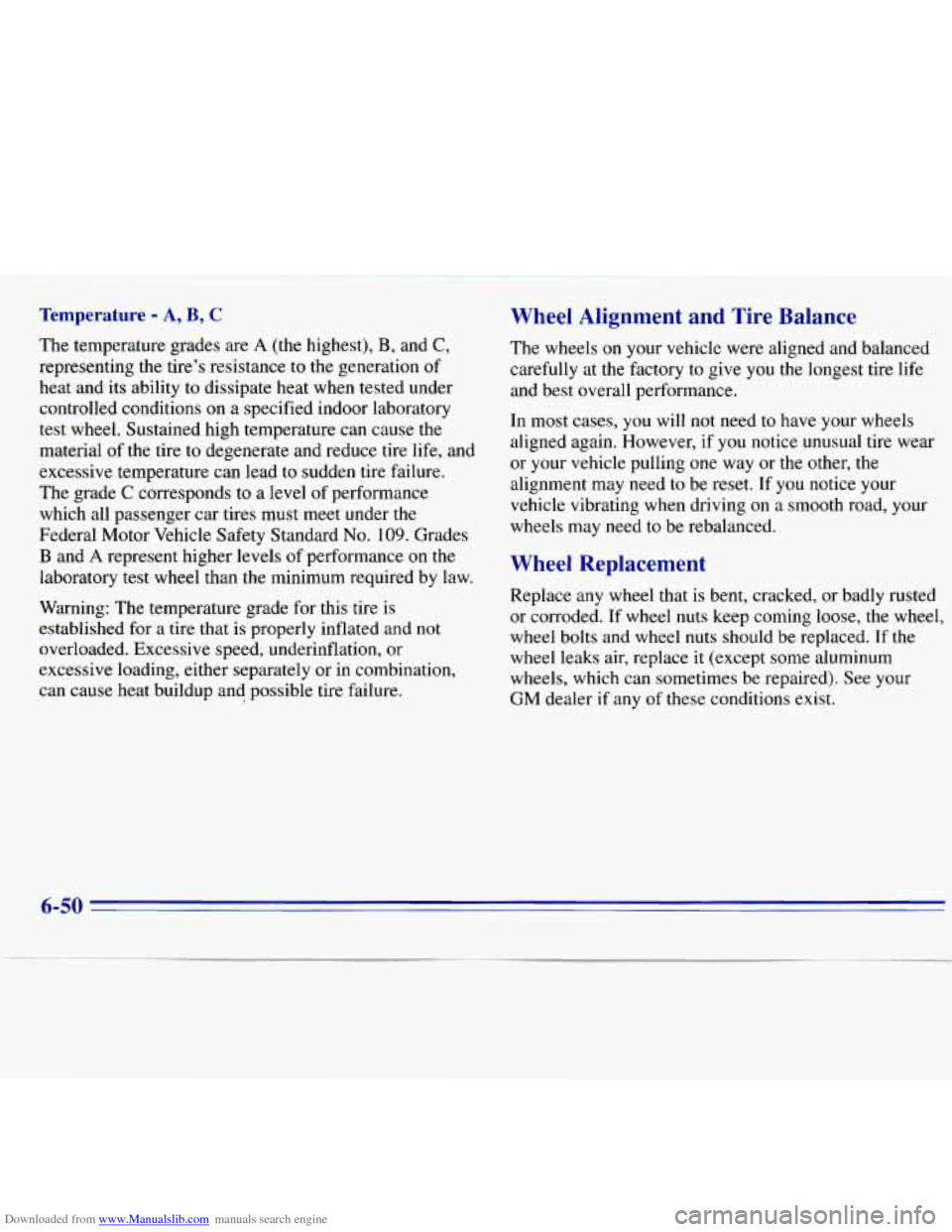
Downloaded from www.Manualslib.com manuals search engine Temperature - A, B, C
The temperature grades are A (the highest), B, and C,
representing the tire’s resistance to the generation of
heat and its ability
to dissipate heat when tested under
controlled conditions on a specified indoor laboratory
test wheel. Sustained high temperature can cause the
material
of the tire to degenerate and reduce tire life, and
excessive temperature can lead
to sudden tire failure.
The grade
C corresponds to a level of performance
which all passenger car tires must meet under the
Federal Motor Vehicle Safety Standard
No. 109. Grades
B and A represent higher levels of performance on the
laboratory test wheel than the minimum required by law.
Warning: The temperature grade for this tire
is
established for a tire that is properly inflated and not
overloaded. Excessive speed, underinflation, or
excessive loading, either separately or in combination,
can cause heat buildup and possible tire failure.
Wheel Alignment and Tire Balance
The wheels on your vehicle were aligned and balanced
carefully at the factory to give
you the longest tire life
and best overall performance.
In most cases, you will not need to have your wheels
aligned again. However, if
you notice unusual tire wear
or your vehicle pulling one way or the other, the
alignment may need to be reset. If
you notice your
vehicle vibrating when driving on a smooth road, your
wheels may need
to be rebalanced.
Wheel Replacement
Replace any wheel that is bent, cracked, or badly rusted
or corroded. If wheel nuts keep coming loose, the wheel,
wheel bolts and wheel nuts should
be replaced. If the
wheel leaks air, replace it (except some aluminum
wheels, which can sometimes be repaired). See your
GM dealer if any of these conditions exist.
6-50
Page 277 of 375
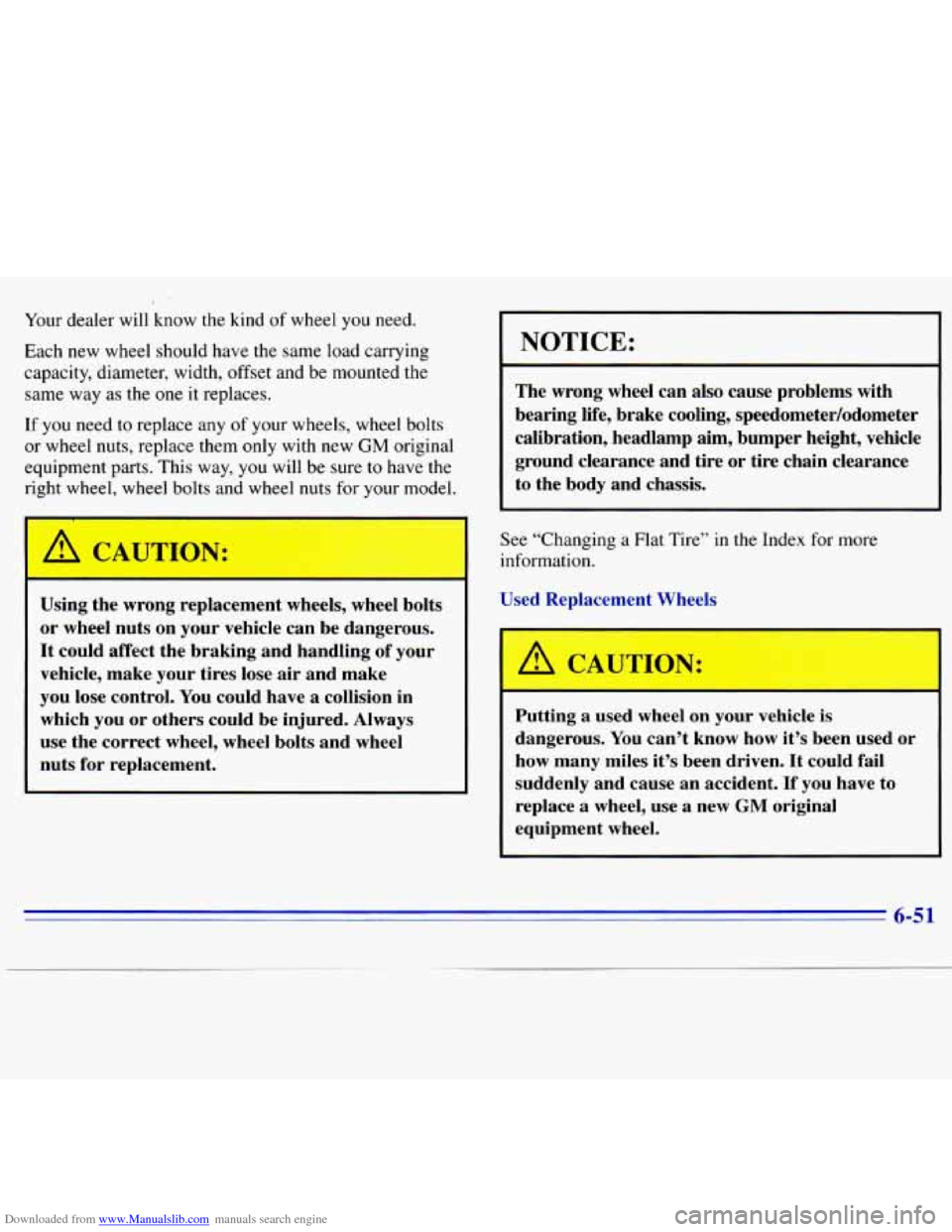
Downloaded from www.Manualslib.com manuals search engine Your dealer will know the kind of wheel you need.
Each new wheel should have the same load carrying
capacity, diameter, width, offset and be mounted the same way as the one it replaces.
If you need
to replace any of your wheels, wheel bolts
or wheel nuts, replace them only with new
GM original
equipment parts. This way, you will be sure
to have the
right wheel, wheel bolts and wheel nuts for your model.
Using the wrong replacement wheels, wheel bolts
or wheel nuts on your vehicle can be dangerous.
It could affect the braking and handling
of your
vehicle, make your tires lose air and make
you lose control.
You could have a collision in
which you or others could be injured. Always
use the correct wheel, wheel bolts and wheel
nuts for replacement.
NOTICE:
The wrong wheel can also cause problems with
bearing life, brake cooling, speedometer/odometer
calibration, headlamp aim, bumper height, vehicle
ground clearance and tire or tire chain clearance
to the body and chassis,
See “Changing a Flat Tire” in the Index for more
information.
sed Replacement
7 keels
Putting
a used wheel on your vehicle is
dangerous. You can’t know how it’s been used or
how many miles it’s been driven, It could fail
suddenly and cause an accident.
If you have to
replace a wheel, use
a new GM original
equipment wheel.
6-51
Page 278 of 375
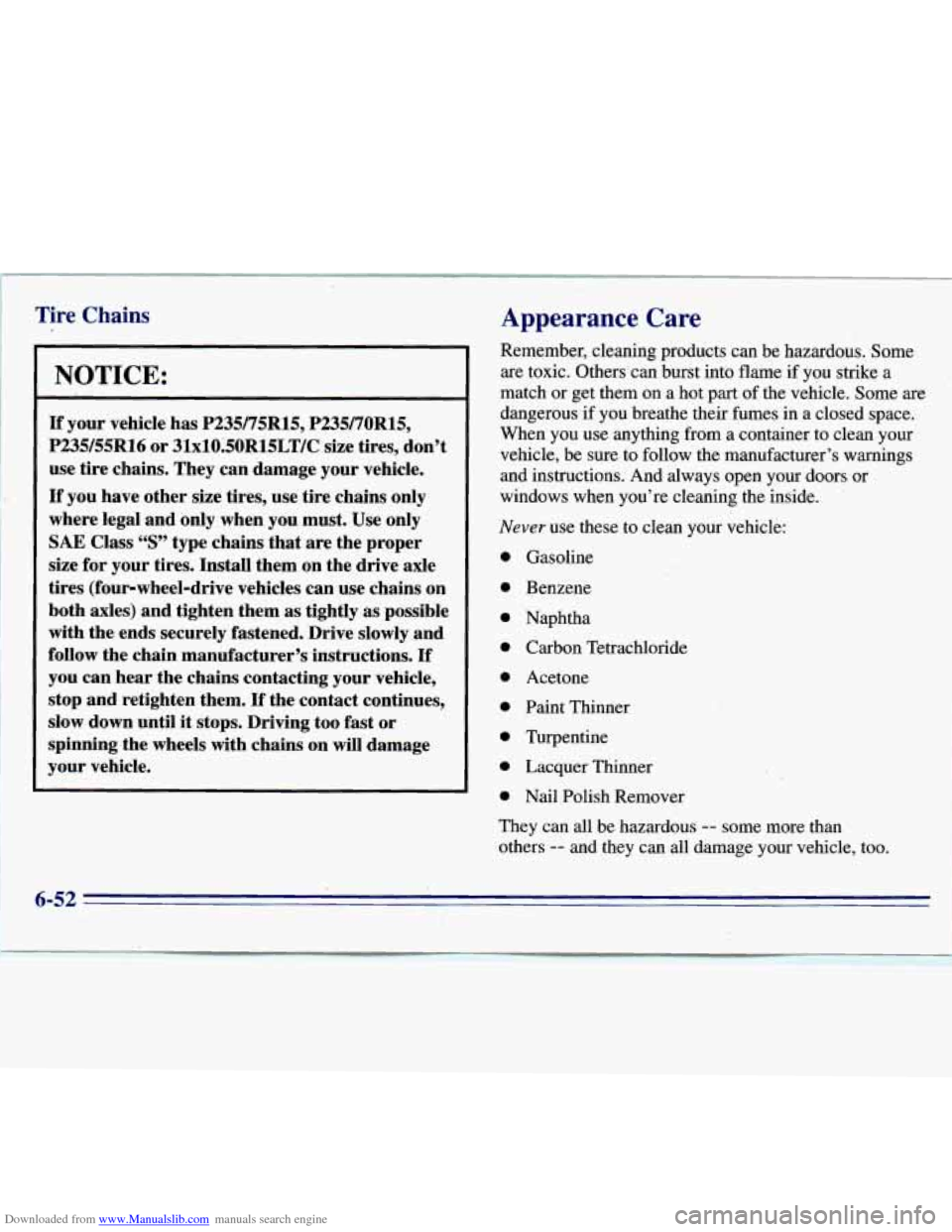
Downloaded from www.Manualslib.com manuals search engine Tire Chains
NOTICE:
If your vehicle has P235/75R15, P23970R15,
P235/55R16 or 3lxlO.5OR15LT/C size tires, don’t
use tire chains. They can damage your vehicle.
If you have other size tires, use tire chains only
where legal and only when you must. Use only
SAE Class “S” type chains that are the proper
size for your tires. Install them on the drive axle
tires (four-wheel-drive vehicles can use chains on
both axles) and tighten them as tightly as possible
with the ends securely fastened. Drive slowly and
follow the chain manufacturer’s instructions.
If
you can hear the chains contacting your vehicle,
stop and retighten them.
If the contact continues,
slow down until it stops. Driving too fast or
spinning the wheels with chains on will damage
your vehicle.
Appearance Care
Remember, cleaning products can be hazardous. Some
are toxic. Others can burst into flame if you strike a
match or get them
on a hot part of the vehicle. Some are
dangerous if you breathe their fumes in a closed space.
When
you use anything from a container to clean your
vehicle, be sure to follow the manufacturer’s warnings
and instructions. And always open your doors or
windows when you’re cleaning the inside.
Never use these to clean your vehicle:
0 Gasoline
0 Benzene
0 Naphtha
0 Carbon Tetrachloride
0 Acetone
0 Paint Thinner
0 Turpentine
0 Lacquer Thinner
0 Nail Polish Remover
They can all be hazardous
-- some more than
others
-- and they can all damage your vehicle, too.
I
‘ 6-52
Page 284 of 375
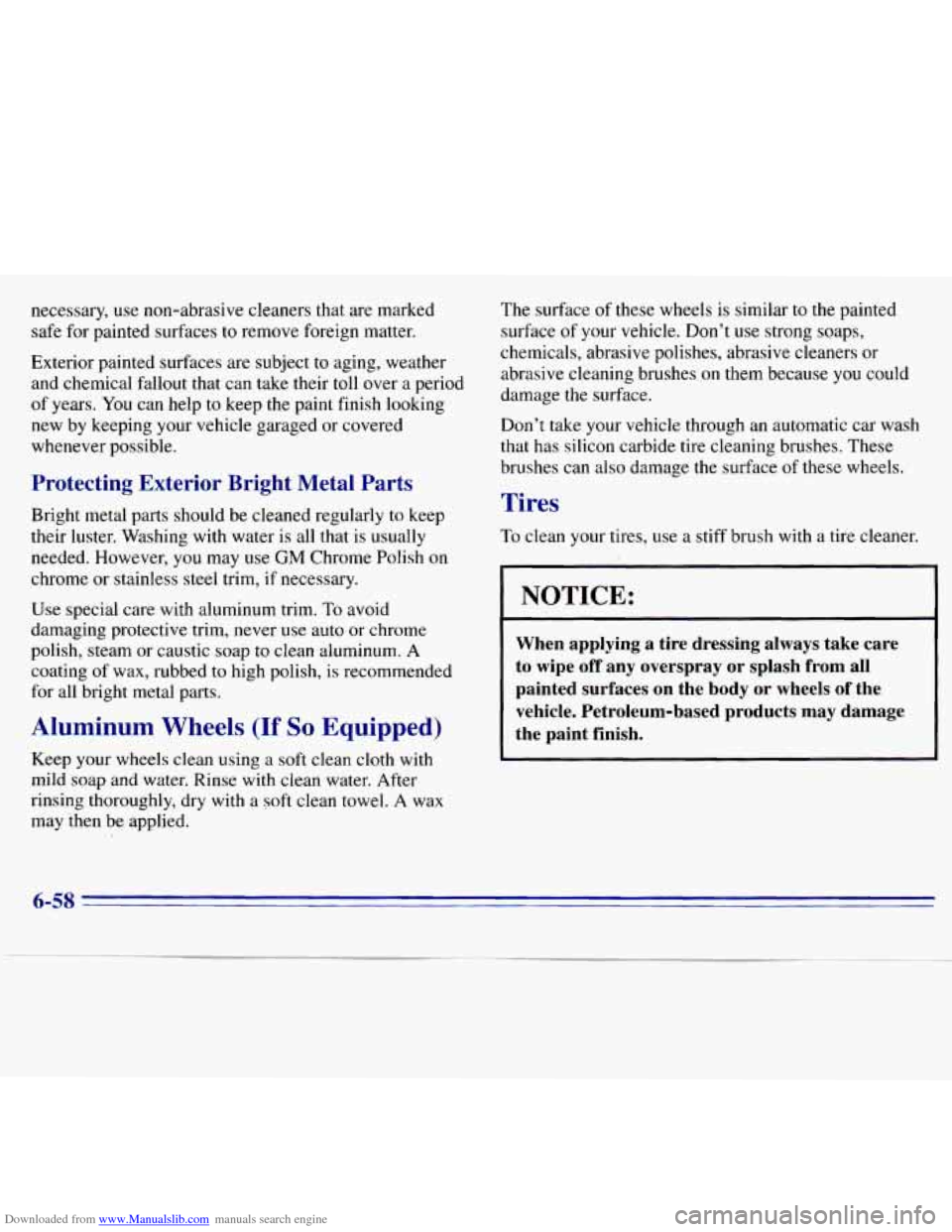
Downloaded from www.Manualslib.com manuals search engine necessary, use non-abrasive cleaners that are marked
safe for painted surfaces
to remove foreign matter.
Exterior painted surfaces are subject to aging, weather
and chemical fallout that can take their toll over a period
of years. You can help to keep the paint finish looking
new by keeping your vehicle garaged or covered
whenever possible.
Protecting Exterior Bright Metal Parts
Bright metal parts should be cleaned regularly to keep
their luster. Washing with water is all that is usually
needed. However, you may
use GM Chrome Polish on
chrome or stainless steel trim, if necessary.
Use special care with aluminum trim.
To avoid
damaging protective trim, never use auto or chrome
polish, steam or caustic soap
to clean aluminum. A
coating
of wax, rubbed to high polish, is recommended
for all bright metal parts.
Aluminum Wheels (If So Equipped)
Keep your wheels clean using a soft clean cloth with
mild soap and water. Rinse with clean water. After
rinsing thoroughly, dry with a
soft clean towel. A wax
may then be applied. The
surface
of these wheels is similar to the painted
surface of your vehicle. Don’t use strong soaps,
chemicals, abrasive polishes, abrasive cleaners or
abrasive cleaning brushes
on them because you could
damage the surface.
Don’t take your vehicle through an automatic car wash
that has silicon carbide tire cleaning brushes. These
brushes can also damage
the surface of these wheels.
Tires
To clean your tires, use a stiff brush with a tire cleaner.
NOTICE:
When applying a tire dressing,always take care
to wipe
off any overspray or splash from all
painted surfaces on the body
or wheels of the
vehicle. Petroleum-based products may damage
the paint finish.
6-58
Page 286 of 375
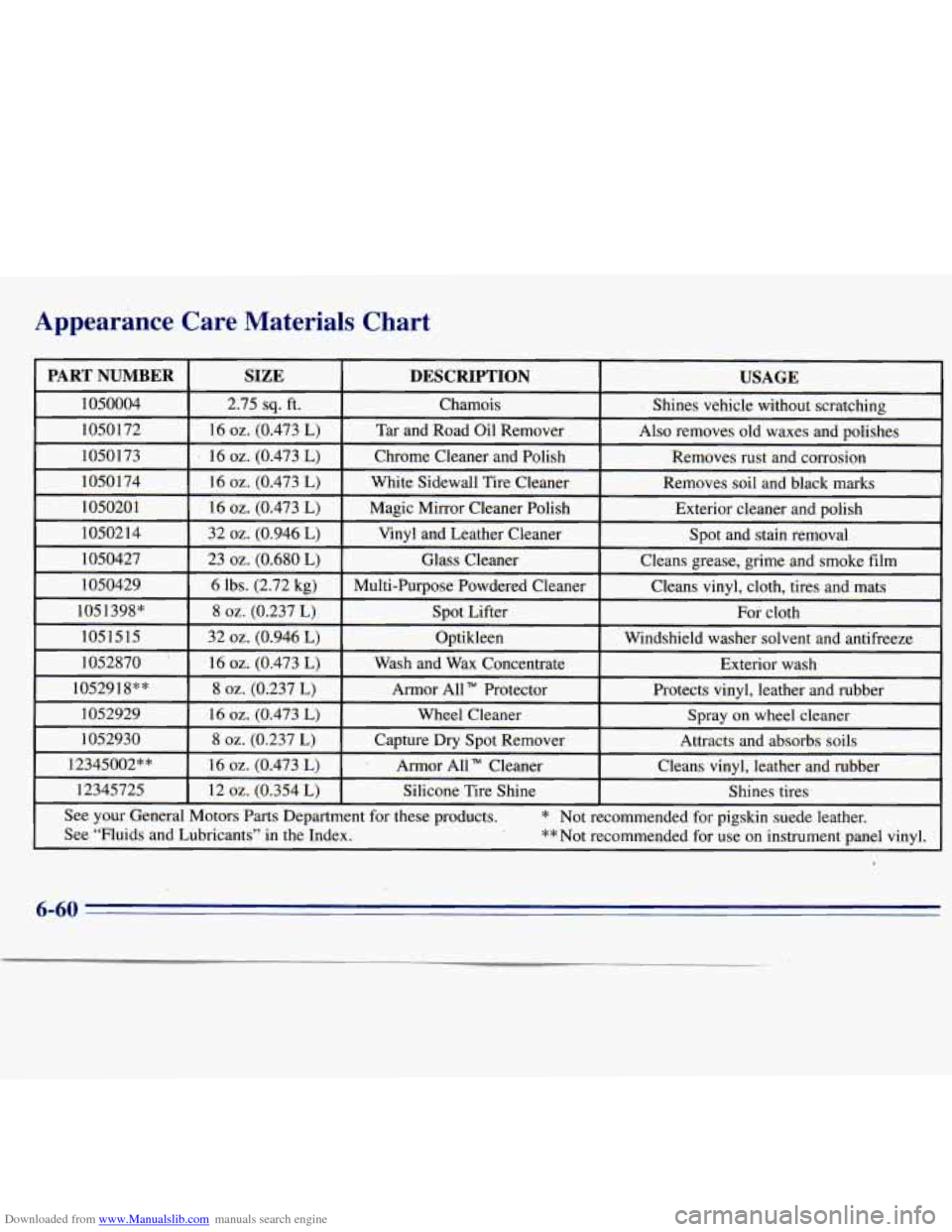
Downloaded from www.Manualslib.com manuals search engine Appearance Care Materials Chart
1051515 32 oz. (0.946 L) Optikleen Windshield washer solvent and antifreeze
1052870 16
oz. (0.473 L) Wash and Wax Concentrate Exterior wash '
I 1052918** I 8 oz. (0.237 L) I hmor All"'' Protector 7 Protects vinyl, leather and rubber
1052929
16 oz. (0.473 L) Wheel Cleaner Spray on wheel cleaner
1052930
8 oz. (0.237 L) Capture Dry Spot Remover Attracts and absorbs soils
12345002"" 16
oz. (0.473 L) .- Armor All TM Cleaner Cleans vinyl, leather and rubber
See your General Motors Parts Department for these products,
* Not recommended for pigskin suede leather.
See "Fluids and Lubricants'' in the Index.
' **Not recommended for use on instrument panel vinyl.
12345725
12
oz. (0.354 L) Silicone Tire Shine Shines tires
6-60
Page 290 of 375

Downloaded from www.Manualslib.com manuals search engine FuseKircuit Usage Breaker
A
B
1
Power Door Locks, Power Seat, Power
Seat Lumbar, Remote Keyless Entry
Power Windows
Stoplamps, Hazard Lamps, Chime,
Center High-Mounted Stoplamp Relay,
Center High-Mounted Stoplamp
3
4
5
6
FuseKircuit Usage
Breaker
2 Dome Lamps, Visor Vanity Mirror,
Cigarette Lighter, Inside Rearview
Mirror Lamp, Overhead Console
Lamps, Glove
Box Lamp, Horns, Horn
Relay, IP Courtesy Lamps, Power
Outside Rearview Mirror, Illuminated
Entry Module
Parking Lamps, License Plate Lamps,
Electric Shift Transfer Case Module,
Underhood Lamp, Ashtray Lamp,
Door Switch Lamp
Alternator Field, A/C Compressor
Relay, Cluster Chime Module, DRL
Relay Coil, Four-Wheel-Drive
Indicator Lamp, DRL Module,
Transfer Case Control Module Ignition, SIR Redundant Ignition,
RKE Ignition
Oxygen Sensor Heater, Exhaust Gas
Recirculation, Cam Sensor, CANN.
Purge, MAS
Blower Motor, Temperature Door
Motor,
HI Blower Relay Coil
6-64
Page 291 of 375

Downloaded from www.Manualslib.com manuals search engine Fuse/Circuit Usage Breaker
7 Power Auxiliary Outlets, Assembly
Line Diagnostic Link
8
9
10
11
12
13
14
15
Not Used
PCMNCM Battery,
ABS Battery, Fuel
Pump (LN2)
PCM/VCM Ignition, Injectors, Crank
Sensor, Coil Driver Module
Radio, Inside Rearview Mirror
Map Lamp
DRAC, Anti-Lock Braking System,
Clock, Radio, Battery,
CD Player
VCM
IGN-3
A/C Compressor Battery Feed
Daytime Running Lamps,
Fog Lamps,
Fog Lamp Relay
Fuse/Circuit Usage Breaker
16
17
19
20 21
22
24 Turn
Signals and Back-up
Lamps, Brake-Transmission
Shift Interlock Solenoid
Windshield Washer, Windshield Wiper Motor
Electric Shift Transfer Case
Crank Signal, Air Bag System
Cluster Illumination,
Radio Illumination, Heater
Lamp, Four- Wheel-Drive
Illumination, Chime Module,
Fog Lamp Illumination
Air Bag System
PRNDL Power, 4L60E Automatic
Transmission
6-65
Page 294 of 375
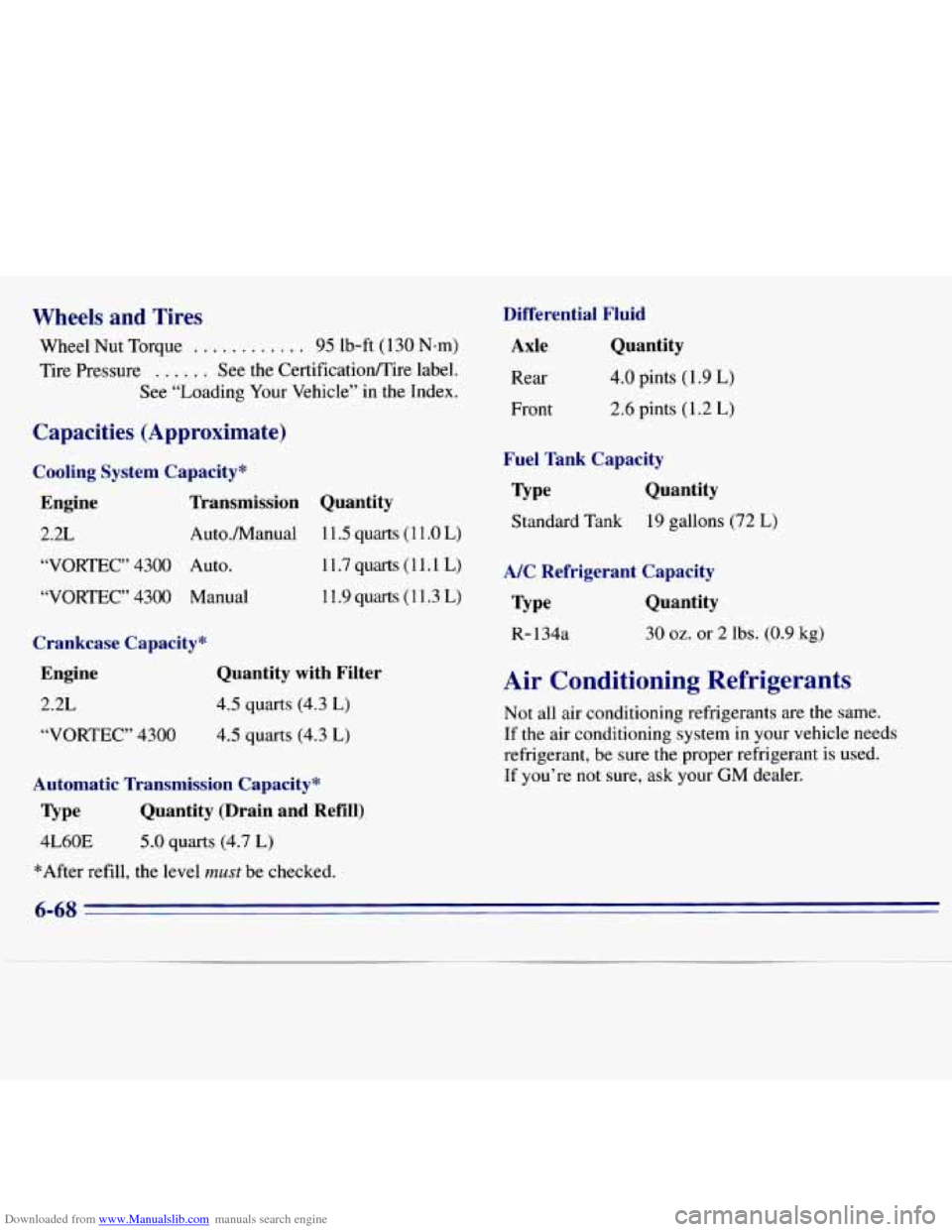
Downloaded from www.Manualslib.com manuals search engine Wheels and Tires
Wheel Nut Torque . . . . . . . . . . . . 95 lb-ft (130 N-m)
Tire Pressure . . . . . . See the Certificatiod‘Tire label.
See “Loading Your Vehicle”
in the Index.
Capacities (Approximate)
Cooling System Capacity*
Engine Transmission Quantity
2.2L Auto./Manual 1 1.5 quarts (1 1 .O L)
“VORTEC” 4300 Auto. 11.7quarts(11.1
L)
“VORTEC” 4300 Manual
11.9quarts(11.3L)
Crankcase Capacity*
Engine Quantity with Filter
2.2L 4.5 quarts (4.3 L)
“VORTEC” 4300 4.5 quarts (4.3 L)
Automatic Transmission Capacity*
Type Quantity (Drain and Refill)
4L60E 5.0 quarts (4.7 L)
*After refill, the level must be checked.
Differential Fluid
Axle Quantity
Rear 4.0 pints (1.9 L)
Front 2.6 pints (1.2 L)
Fuel Tank Capacity
Type Quantity
Standard Tank 19 gallons (72 L)
A/C Refrigerant Capacity
Type Quantity
R- 134a 30 oz. or 2 lbs. (0.9 kg)
Air Conditioning Refrigerants
Not all air conditioning refrigerants are the same.
If the air conditioning system in your vehicle needs
refrigerant, be sure the proper refrigerant is used.
If you’re not sure, ask your GM dealer.
6-68